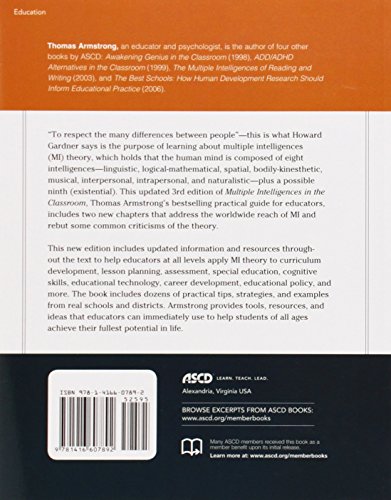



Full description not available
M**A
Practical guidance for differentiating for different MI's
Multiple intelligences in the classroom is an excellent resource because it explains the different intelligences in practical language, and gives helpful lists of activities that would appeal to each intelligence. Armstrong set out to give teachers a practical understanding of multiple intelligences. He adapts Howard Gardner’s theories into a more applicable format to daily classroom instruction. He also gives a large number of examples of different activities and instructional strategies that can appeal to the different multiple intelligences. He presents these strategies as not just a way to make classroom instruction more dynamic and more interesting for students, but also as a way to unlock the talents and abilities of exceptional students. Often he engages the material on behalf of special needs students, but also gives examples of how these ideas may be applied to mainstream and to gifted students. He presents the different activities as ways of engaging students, but also as ways of providing holistic education. The different intelligences interact with each other in very interesting ways, and can promote cooperative learning and can encourage students to learn in ways that are not in their own areas of preference. He lists and describes ideas that can be applied immediately to the classroom environment. It is clear that these ideas can help energize the classroom, and even help with classroom management.
S**N
Useful and Well-Written
If you are trying to be a teacher who teaches to the needs of each student, rather than a teacher who favors only 1-2 types of learner, then I highly recommend this book. Admittedly, Multiple Intelligences is currently one of the go-to buzzwords in K-12 education (and even college education), which made me hesitant at first to do much reading about it (since I figured they'd just be completely discarding the whole idea for a new one or recycled old one in a few more years), but once I did some research, I found myself agreeing with much of this. I don't think this book is the end-all solution to the current crisis in American education, but it is a well-written book that will make you rethink how you teach and will help you to come up with ideas that will better reach many of your students. So, if you use it, you become a better teacher and your students have a better learning experience. I call that a win-win.
L**M
Multiple Intellegences
Speedy delivery and book is in great shape. Only bought and read it because I was forced to by a new administrator. I don't care for the concept of the book or how it is written as it doesn't flow smoothly and is not straight forward. Just another money maker for an author. Being (an almost retired) teacher, it is my belief after 40 years of raising and teaching 1000's of children, that this kind of thinking just creates more need (in the minds of modern day educators and social service systems) for labeling and government entitlement programs which aren't good for any people or nation.
M**E
New ways to unravel human potential
Multiple Intelligences in the Classroom A real research opening new gates and showing paths to regard every child (and human being in general) as "mines rich in gems of precious value". Written in a sincere and clear language, it gives an accessible way to discover and deepen how we learn, how we understand, how we feel, how we live in this world.It is a good call for education to go further in this kind of research !
B**A
How do I reach all students in the language classroom?
Who are the students in the classroom is best answered when you consider their preferred or strongest kind(s) of intelligence. when you aim to reach all of them, that becomes the most important first step then, The book contains a MI inventory if you do not have one, also it approaches in a simple and realistic way how you should plan for all kinds of intelligence, that way you can reach the aim, reach and also help develop eight kinds of intelligence.Other topics as profound thinking on origins and end of life, love and violence are not considered, but you can documment yourself independently.
A**Q
Excellent READABLE Resource
So many times I've ordered an book, whether for one of my Education classes, or now as a licensed educator, and the author uses technical terminology befitting their theories. Armstrong however takes Gardner's theory of multiple intelligences and offers a readable view to understand this approach. The book is extremely well organized and broken down into manageable, helpful parts. Also, for once a book that is designed for all educators truly does help those in the upper levels! Elementary through high school teachers would find this an excellent resource to add to their collection. What I enjoy best about this book is that I can incorporate it into my current methods!
M**T
Great for Practical Use
I think Armstrong gives a great overview of Garnder's Intelligences along with real practical applications for the classroom and tutoring. I'm a visual learner, so I really appreciated the charts and tables with examples of each intelligence in various situations or disciplines. This book will definitely live on the shelf in my office for years to come, and I would definitely recommend it to other new teachers trying to use Multiple Intelligences in their classrooms.
A**E
Good book for into to MI
Good text. Got it for a class I took. Didnt read the whole thing, just assigned parts.
D**E
Very interesting book
Well done and well written! Very interesting to learn why and how to implement the multiple intelligences theory in the classroom.
Trustpilot
1 month ago
1 month ago